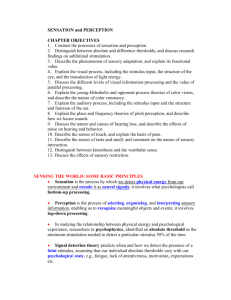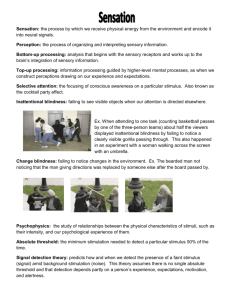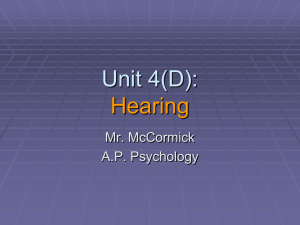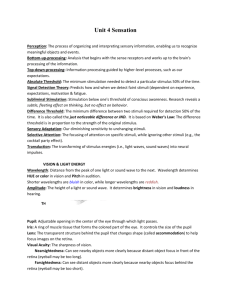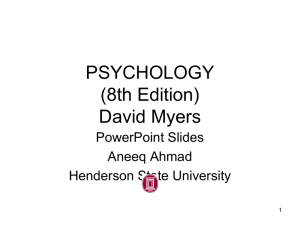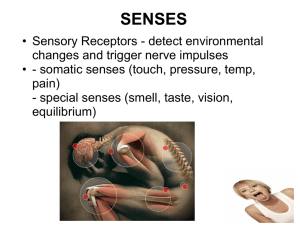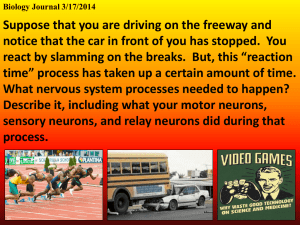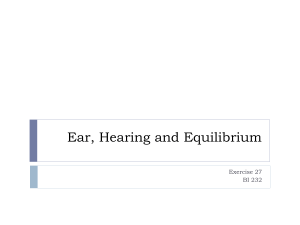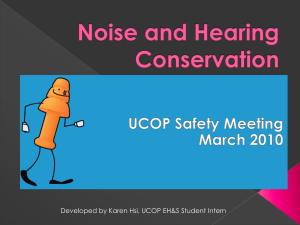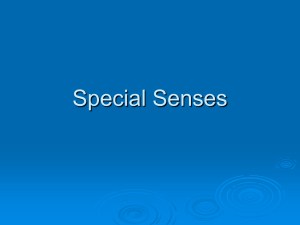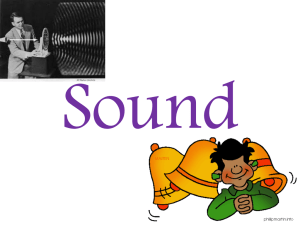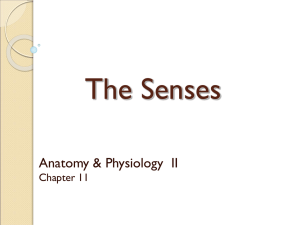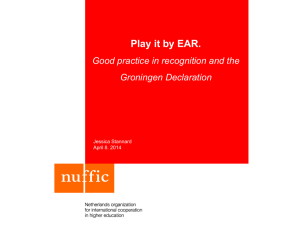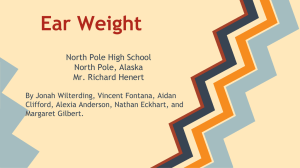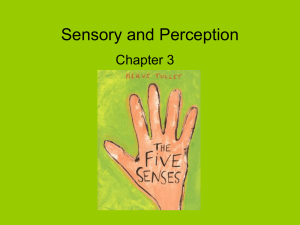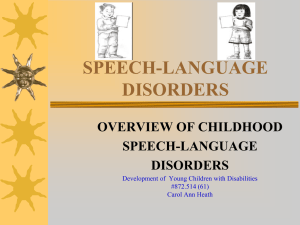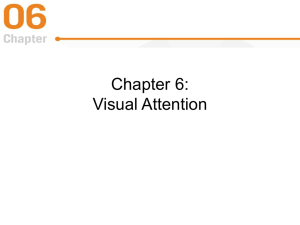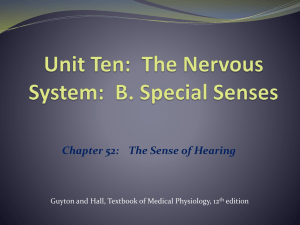Sensation
advertisement
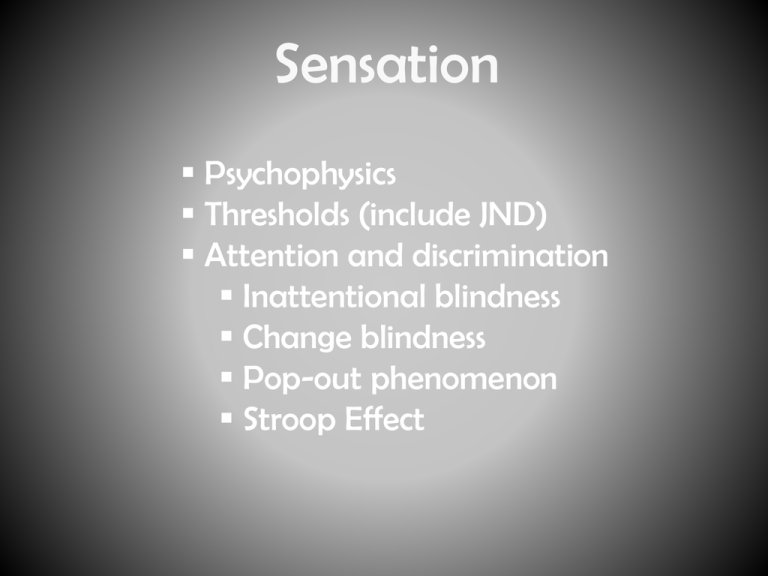
Sensation Psychophysics Thresholds (include JND) Attention and discrimination Inattentional blindness Change blindness Pop-out phenomenon Stroop Effect Sensation & Perception How do we construct our representations of the external world? To represent the world, we must detect physical energy (stimulus) from the environment and convert it into neural signals, a process called sensation. When we select, organize, and interpret our sensations, the process is called perception. Psychophysics • Studies the links between physical stimuli in the world and the psychological experience of those stimuli • Fechner, Wundt, Titchener, Weber • Among the earliest research to be conducted in the field of Psychology Bottom-up Processing (sensation) Analysis of the stimulus begins with the sense receptors and works up to the level of the brain and mind. Letter “A” is sensed as a black blotch decomposed into features by the brain and perceived as an “A” by our mind . Top-Down Processing (perception) Information processing guided by higher-level mental processes as we construct perceptions drawing on our experience and expectations. THE CHT Making Sense of Complexity Our sensory and perceptual processes work together to help us sort out complex images. “The Forest Has Eyes,” Bev Doolittle Exploring the Senses 1. What stimuli cross our threshold for conscious awareness? 2. Could we be influenced by stimuli too weak (subliminal) to be perceived? 3. Why are we unaware of unchanging stimuli, like a band-aid on our skin or the feeling from our shoes? Thresholds Absolute Threshold: Minimum stimulation needed to detect a particular stimulus 50% of the time. For example, young children generally have a lower absolute threshold for sounds since the ability to detect sounds at the lowest and highest ranges tends to decrease with age. Subliminal Threshold When stimuli are below one’s absolute threshold for conscious awareness. Detect it less than 50% of the time Difference Threshold Difference Threshold: Minimum difference between two stimuli required for detection 50% of the time, also called just noticeable difference (JND). For example, if you were asked to hold two objects of different weights, the just noticeable difference would be the minimum weight difference between the two that you could sense half of the time. Weber’s Law explains the JND Two stimuli must differ by a constant minimum proportion (rather than a constant amount), to be perceived as different. Weber fraction: k = dI/I. Stimulus Constant (k) Light 8% Weight 2% Tone 3% Signal Detection Theory • Predicts when we will detect weak signals • Ask why people respond differently to the same stimuli?? • Why does the same person’s response vary as the circumstance changes • Sensitivity and responsiveness increases with emotional state • Example: Hearing your baby cry… Sensory Adaptation Diminished sensitivity as a consequence of constant stimulation. Sometimes referred to as habituation Put a band aid on your arm and after a while you don’t sense it. Selective Attention Perceptions about objects change from moment to moment. Different forms of Necker cube become available to our perception, however, one can pay attention only to one aspect of the object. Necker Cube Selective Attention • Discrimination – we have the ability to filter out stimuli rather than process every single stimuli that is bombarding our sensory receptors, will be helpful in conditioning (learning by association) • Cocktail party effect – the ability to focus one's listening attention on a single talker among a mixture of conversations and background noises, ignoring other conversations. Inattentional Blindness Inattentional blindness refers to inability to see a an object or a person amidst an engrossing scene. Keep your eye on the ball and count how many times the team with the white shirts passes it… Change Blindness Change blindness is a form of inattentional blindness, where two-thirds of direction giving individuals failed to notice a change in the individual who was asking for directions. Pop-out phenomenon • A powerful and distinct stimulus demands our attention • We don’t choose to see them, can’t ignore it • A type of automatic processing Automatic processing Controlled processing Stroop Effect • Our brain can process information faster when it is presented in the way we expect it • When too many areas of our brain are active, we have a pause in our processing • Try this…http://faculty.washington.edu/chudler/ja va/ready.html Name the color of the font AP stuff • Stimulus attention – Selective attention (cock-tail party) – Stimulus discrimination – Habituation • Thresholds – Absolute (detectable greater than 50% of time) – Subliminal (detectable less than 50% of time) – Just noticeable difference (Weber’s Law) • It’s a proportion of the original stimulus Vision Types of Transduction Light and Sound Characteristics Parts of the eye The process of vision Cells within the retina Shape Detectors and Feature Detectors Theories of vision Transduction In sensation, transformation of stimulus energy into neural impulses. Phototransduction: Conversion of light energy into neural impulses that brain can understand (the rods and cones in the retina) Auditory/Acoustic transduction: Conversion of sound waves into neural impulses (the cilia in the cochlea) Light Characteristics 1. Wavelength (hue/color) 2. Intensity (brightness) 3. Saturation (purity) Wavelength (Hue) Hue (color): dimension of color determined by wavelength of light. Wavelength the distance from the peak of one wave to the peak of the next. Intensity (Brightness) Intensity Amount of energy in a wave determined by amplitude; related to perceived brightness. The Eye Parts of the eye 1. 2. 3. 4. Cornea: Transparent tissue where light enters the eye. Iris: Muscle that expands and contracts to change the size of opening (pupil) for light. Lens: Focuses the light rays on the retina. Retina: Contains sensory receptors that process visual information and send it to the brain. The Lens Lens: Transparent structure behind pupil that changes shape to focus images on the retina. Accommodation: The process by which the eye’s lens changes shape to help focus near or far objects on the retina. The Lens Nearsightedness: A condition in which nearby objects are seen more clearly than distant objects. Farsightedness: A condition in which faraway objects are seen more clearly than near objects. Fovea Retina Retina: The lightsensitive inner surface of the eye, containing receptor rods and cones plus layers of other neurons (bipolar, ganglion cells) that process visual information. Bipolar & Ganglion Cells Bipolar cells receive messages from the photoreceptor cells (rods and cones) and transmit those messages to ganglion cells which have long axons that are intertwined and form the optic nerve. Optic Nerve, Blind Spot & Fovea Optic nerve: Carries neural impulses from the eye to the brain. Blind Spot: Point where optic nerve leaves the eye, because there are no receptor cells located here, it creates a blind spot. Fovea: Central point in the retina, around which the eye’s cones cluster. http://www.bergen.org Test your Blind Spot Use your textbook. Close your left eye, and with the right eye fixate on the black dot. Move the page towards and away from your eye. At some point the car on the right will disappear due to blind spot. Or, take a piece of paper, roll it up, look through it with one eye and bring your opposite hand next to the paper. There should be a hole in your hand!!!! (thanks Emilie B.) Photoreceptors E.R. Lewis, Y.Y. Zeevi, F.S Werblin, 1969 Why don’t they see which color it is? Feature Detection Nerve cells in the visual cortex respond to specific features, like edges, angle, and movement. Feature detectors allow us to see the lines, motion, curves of this power point slide What happens when you overwhelm these feature detectors? Watch the center of the spiral… Shape Detection Ishai, Ungerleider, Martin and Haxby/ NIMH Specific combinations of temporal lobe activity occur as people look at shoes, faces, chairs and houses. Perception in Brain Our perceptions are a combination of sensory (bottom-up) and cognitive (top-down) processes. Visual Information Processing Processing of several aspects of the stimulus simultaneously is called parallel processing. The brain divides a visual scene into subdivisions such as color, depth, form and movement etc. Watch the car video closely and note the different forms of processing that are occurring simultaneously… 2 Theories of Color Vision Trichromatic theory: Based on behavioral experiments, Young-Helmholtz suggested that retina contains three receptors sensitive to red, blue and green colors. Color Blindness Genetic disorder in which people are blind to green or red colors supports Trichromatic theory. Opponent Process Theory • As our receptor cells sense colors in our environment, the cones are also firing the opponent (opposite) color BlackWhite RedGreen BlueYellow Gaze at the middle of the flag for about 30 seconds… Afterimage Effect Dark adaptation • The process by which the rods and cones adjust to changes in levels of light • Rods are more sensitive to light and so take longer to fully adapt to the change in light • The fovea is blind to dim light (due to its cone-only array) and the rods are more sensitive • Insufficient adaptation to dark environment, called “night blindness”. Color Constancy Color of an object remains the same under different illuminations. However, when context changes color of an object may look different. R. Beau Lotto at University College, London AP stuff… • Cornea-pupil-lens-retina-photoreceptorsbipolar-ganglion-optic nerve-visual cortex • Photo transduction takes place in the rods (light) and cones (color) • Fovea is the point of focus (what happens if..) • Why a blind spot? • Real image and virtual image (WOW!) • Remember frequency and amplitude Hearing Parts of the Ear and the hearing process Theories of audition Hearing loss The Stimulus Input: Sound Waves Sound waves are composed of compression and rarefaction of air molecules. Acoustical transduction: Conversion of sound waves into neural impulses in the cilia (hairs cells) of the inner ear. Sound Characteristics 1. Frequency (pitch) 2. Intensity (loudness) 3. Quality (timbre) Frequency (Pitch) Frequency (pitch): Dimension of frequency determined by wavelength of sound. Wavelength: The distance from the peak of one wave to the peak of the next. Intensity (Loudness) Intensity (Loudness): Amount of energy in a wave determined by amplitude relates to perceived loudness. Loudness of Sound Richard Kaylin/ Stone/ Getty Images 120dB 70dB Quality (Timbre) Quality (Timbre): Characteristics of sound from a zither and a guitar allows the ear to distinguish between the two. http://www.1christian.net www.jamesjonesinstruments.com Zither Guitar The Ear Guess what, you don’t hear with your ear. You hear with your … Outer Ear Pinna: Collects sounds. Shaped like a funnel Auditory canal: The auditory canal is a tube that connects the pinna and the tympanic membrane (eardrum) -funnels sound toward eardrum, protects eardrum Middle Ear Middle Ear: Chamber between eardrum and cochlea containing three tiny bones (“ossicles”-hammer, anvil, stirrup) that concentrate the vibrations of the eardrum on the cochlea’s oval window. Inner Ear Inner Ear: Innermost part of the ear, containing the cochlea, semicircular canals, and vestibular sacs. Cochlea: Coiled, bony, fluid-filled tube in the inner ear that transduces sound vibrations to auditory signals. Process of hearing • 1. Sound waves enter through the pinna and travel through the auditory canal • 2. The sound waves begin to vibrate the tympanic membrane (eardrum) • 3. The ossciles of the middle ear (H.A.S.) move and the stirrup presses on the cochlea’s oval window • 4. Fluid in the cochlea circulates causes the movement of the cilia along the basilar membrane • 5. Neural messages travel along the auditory nerve toward the temporal lobe Video segment on hearing 4 3 2 1 5 Theories of Audition Place Theory suggests that sound frequencies stimulate basilar membrane at specific places resulting in perceived pitch. Some hairs vibrate when the pitch is low and some when it is high, ----this explains detection of high frequencies http://www.pc.rhul.ac.uk Theories of Audition Frequency Theory states that the rate of nerve impulses traveling up the auditory nerve matches the frequency of a tone, thus enabling us to sense its pitch. All hairs vibrate but at different speeds --explains detection of low frequencies Sound Frequency 100 Hz 200 Hz Auditory Nerve Action Potentials Localization of Sounds Because we have two ears sounds that reach one ear faster than the other makes us localize the sound. Hearing Loss Conduction Hearing Loss: Hearing loss caused by damage to the mechanical system that conducts sound waves to the cochlea. The waves never reach the cochlea. Sensorineural Hearing Loss: Hearing loss caused by damage to the cochlea’s receptor cells or to the auditory nerve, also called nerve deafness. Hearing Deficits Older people tend to hear low frequencies well but suffer hearing loss for high frequencies. AP info… • Outer ear (pinna) is shaped like a funnel, auditory canal and ends at tympanic membrane • Middle (mechanical) ear has ossicles – Hammer, Anvil, Stirrup (pushes on oval window) • Inner ear has cochlea, basilar membrane and cilia (acoustic transduction here) • Mechanical and Sensory neural hearing loss • Do you still remember frequency and amplitude? Other Senses Somasthetic sense Gustatory sense Olfaction sense Kinesthetic sense Vestibular sense Touch (somasthetic sense) Bruce Ayers/ Stone/ Getty Images Sense of touch is a mix of four distinct skin sensespressure, warmth, cold, and pain. Touch • Receptors are located all over the skin, some areas more concentrated than others • The sensory cortex located in the parietal lobe receives the information (left side of body=right brain) • The more sensitive a body part is, the more surface area is given to it in the cortex Skin Senses Only pressure has identifiable receptors, all other skin sensations are variations of pressures, warmth, cold and pain. Pressure Burning hot Vibration Vibration Cold, warmth and pain Pain Pain tells the body that something has gone wrong. Usually pain results from damage to the skin and other tissues. There is a rare disease in which the person feels no pain. Ashley Blocker (right) feels neither pain nor extreme hot or cold. Biopsychosocial Influences Gate-Control Theory Melzak and Wall (1965, 1983) proposed that our spinal cord contains neurological “gates” that either block pain or allow it to be sensed. The release of endorphins would close the gate. Gary Comer/ PhototakeUSA.com Pain Control Pain can be controlled by a number of therapies including, drugs, surgery, acupuncture, exercise, hypnosis and even thought distraction. Taste Traditionally taste sensations consisted of sweet, salty, sour and bitter tastes. Recently receptors for a fifth taste have been discovered called “Umami”. Sweet Sour Salty Bitter Umami (Fresh Chicken) Sensory Interaction When one sense affects another sense sensory interaction takes place. So the taste of starburst interacts with its smell and its texture on the tongue to produce flavor. Smell Like taste smell is a chemical sense. Odorants enter the nasal cavity to stimulate 5 millions receptors to sense smell. Unlike taste there are many different forms of smells. Age, Gender and Smell Ability to identify smell peaks during early adulthood but steadily decline after that. Women are better at detecting odors than men. Smell and Memories Brain region (red) for smell is closely connected with brain regions (limbic system) involved with memory, that is why strong memories are made through the sense of smell. Body Position and Movement The sense of our body parts’ position and movement is called kinesthesis (joints and muscles). And the vestibular sense (semicircular canals in inner ear) monitors the head (and body’s) position. Neo learning to move his body Wire walk over Niagara Falls Kinesthetic Sense • provides the parietal cortex of the brain with information on the relative positions of the parts of the body • describes how much we know about where we are in space and where all of our parts are in relationship to each other • Our kinesthetic sense helps us move with greater precision, avoid injuries, and be fully present in the moment • Close your eyes and touch the tip of your nose with the tip of your finger Vestibular Sense (equilibrium) • Monitors the position of the head in relation to the body, the sensations of body rotation and of gravitation and movement • Operates based on movement of fluid within the semi-circular canals of the inner ear • The vestibular system sends signals primarily to the neural structures that control eye movements, and to the muscles that keep a creature upright • Abnormalities may cause “vertigo” Ap stuff… • Transduction – process by which sensory information is transformed into neural impulses. • Adaptation – the decreasing response of a sense when they are exposed to continuous stimulation. • Opponent-process theory – The thalamus of the brain responds to two pairs of colors (red/green and blue/yellow). • Tri-chromatic theory – Cones in the eye pick up three colors: green, red and blue. Ap stuff cont… • Frequency theory – the rate at which nerve impulses reach the brain determine how low the pitch of the sound is. Low pitches have lower frequency. The higher the frequency, the higher the pitch • Place theory – The area within the basilar membrane of the cochlea determines how we hear high pitch sounds More AP info… • Touch- pressure, pain, temperature (not hot) • Taste and smell are chemical senses and linked together (flavor), not in the thalamus • Kinesthetic sense-position of body parts and movement (in joints and muscles) • Vestibular sense-whole body position, balance (in semi-circular canals of the inner ear) • Optic-sight • Acoustic-hearing • Olfactory-smell • Gustatory-taste
